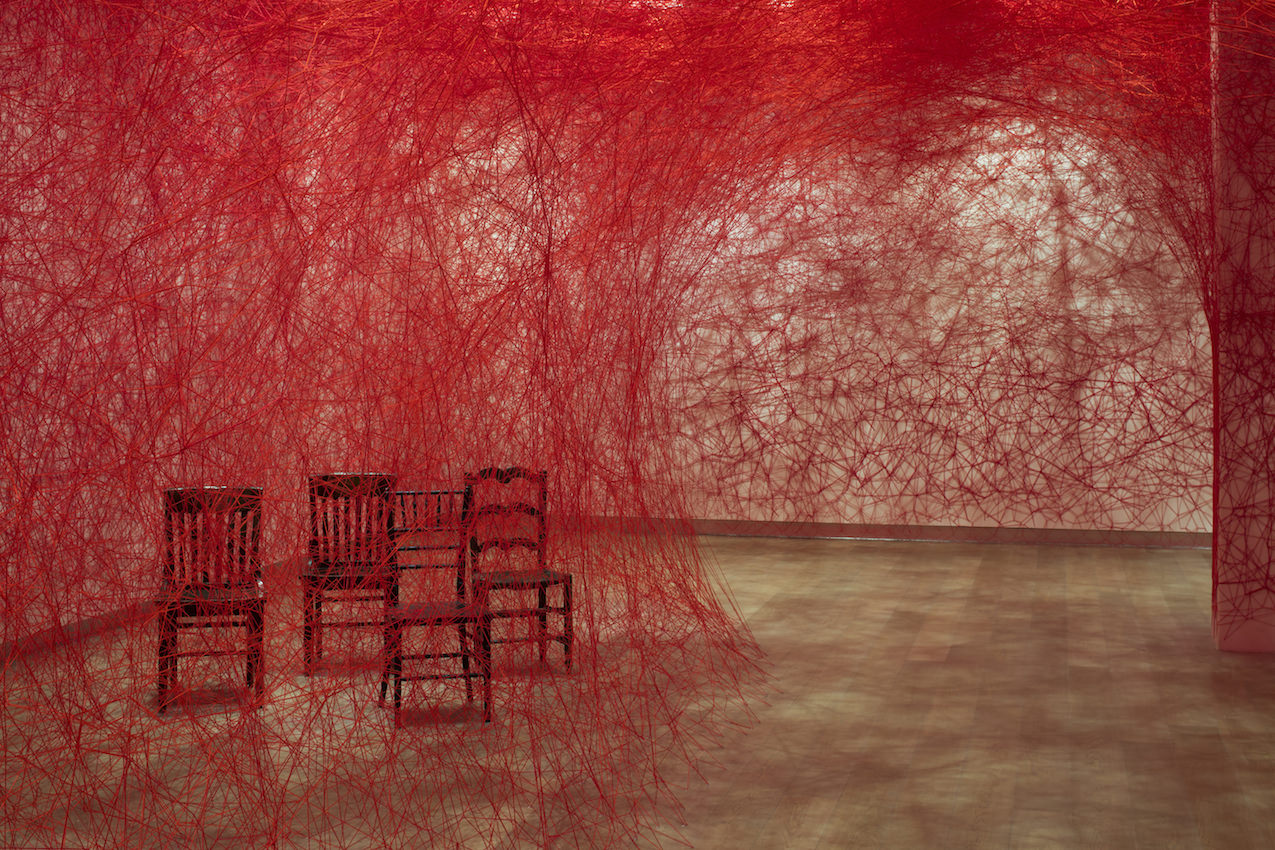Thirty years after the fall of the Berlin wall, the city’s contemporary art scene reflects its lasting impression on the city and the world.
The eighth edition of Berlin Art Week took place September 11-15. Two fairs, 15 private collections, 17 museum and exhibition venues, 20 selected project spaces, and numerous galleries came together in a robust five-day program exploring the political, social, and urban development since the fall of the Berlin wall in 1989.
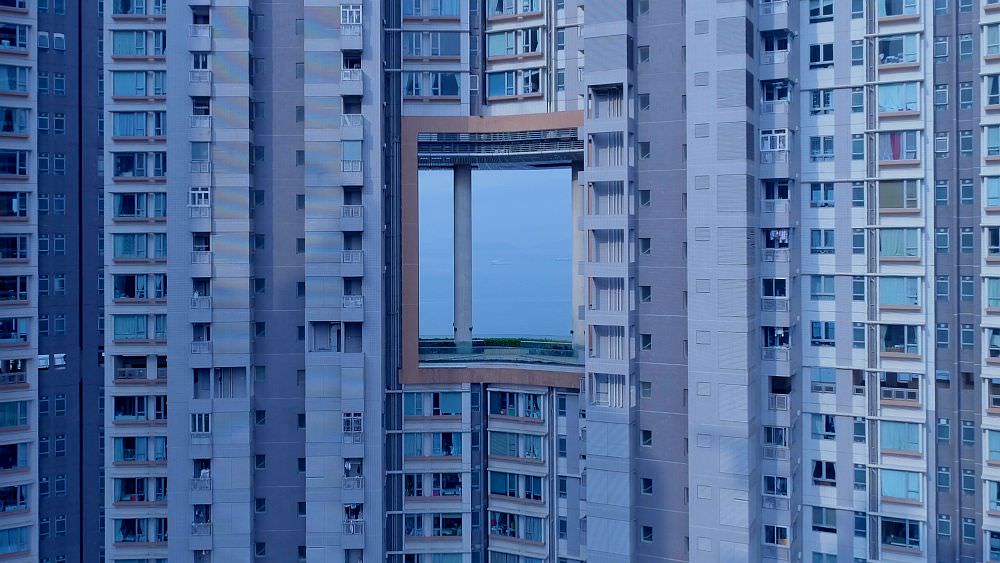
© Julia Stoschek Collection Berlin, WangShui, From its mouth came a river of high-end residential appliances, 2018, Einkanal-Video, Wasser. Videostill. Courtesy of the artist
As a solute to the DIY spirit of Berlin, we rang in the city’s art week at an unsanctioned exhibition, “Busch, Volume 1. AVUS” (September 11—15). Far west of anything “happening” at the abandoned racetrack auditorium, AVUS Tribüne, abuts the autobahn. The audience can see the cars whiz by through the gaps in the temporary wall which was the backdrop for a singer DJ duo. Under the stairs, art hangs where concessions were once sold.
This place—where Hitler watched Harold Whitlock of Great Britain win the 50 km gold medal in 1936—is now the venue for an art magazine launch whose thematic focus is pubic hair. Bizarre juxtapositions, like this one, are typical of creative spaces in Berlin. When the wall fell, East Berlin was all but abandoned until the penniless misfits of the world slowly built it back up into the fashionable districts they are today.
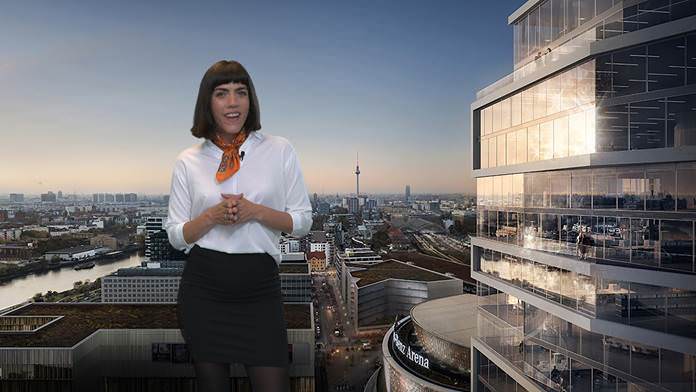
1km² Berlin – The Language of Speculation, 2019 (Filmstill), Guerilla Architects in cooperation with Philine Schneider und Shahrzad Rahmani, Performer Alicia Agustin, Production offscreen
Yet, as Germany celebrates 30 years of unity, the mind turns to the borders still so present in the sociopolitical landscape of today—some physical, some immaterial though no less real—begging the question: How far have we actually come?
“No Photos on the Dance Floor! 1989—Today”
C/O Berlin
September 13 November 30, 2019
Documentation is an important part of most of the world’s nightlife, but anyone who has partied at one of Berlin’s storied clubs knows that photos are absolutely forbidden. One camera flash, and you’ll find yourself swiftly escorted to the nearest exit.
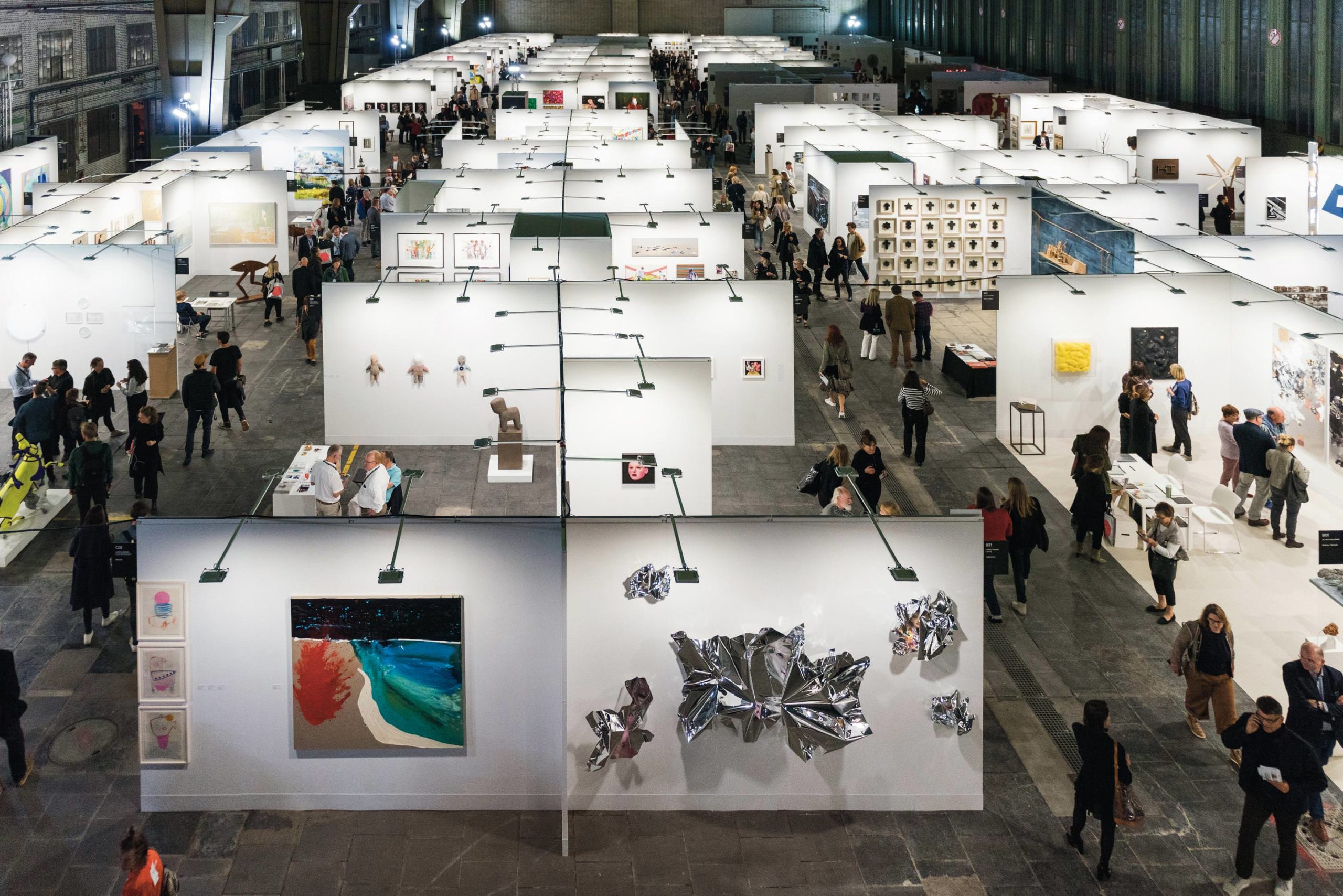
Positions Berlin Art Fair 2018 © Clara Wenzel-Theiler.
“Photo bans allow a tradition to survive in the digital age, one that existed long before digitalization and omnipresent cameras. The tradition of partying together in a space in which you can lose yourself to the music and feel free and safe at the same time. Free from surveillance. Free from consequences and judgement of the outside world.” —Jan Kedves
The main exhibition, with video component, documents Berlin’s clubbing culture from the fall of the wall in 1989 to now. Some literally, as with Salvatore Di Gregorio who spent nine months photographed DJs directly after their sets, and others more figuratively, like Erez Israeli who went to the Berghain nightclub tattooing the stamps he received there to his arm. The parallel to the tattoos given at concentration camps can’t be ignored in this piece, making the audience reflect on the ghosts of these reclaimed spaces.

Sonia Gomes, Aninhado, 2019, Courtesy of Mendes Wood DM São Paulo, Brussels, New York. Copyright of the artist, Photo by Bruno Leão.
C/O will host their own club nights in the adjoining room to the backdrop of Alva Noto’s single channel video Univrs Uniscope R-N, 133-3. A dazzling example of visual audio analysis where deep blue dominates the color palette.
“Horizontal Vertigo” by WangShui
Julia Stoschek Collection Berlin
September 12—15, 2019
WangShui’s first European exhibition, “Horizontal Vertigo” tells a story that’s at times fatalistic, and at times just plain fun. In the first room, Gardens of Perfect Exposure, a sculptural installation of chrome bath fixtures arranged on a hanging plexiglass surface—glows in its darkish environs. With HD-camcorders simultaneously filming and projecting the piece, it becomes apparent that the artwork, which seemed static and clean, almost septic, is alive with organic matter including laminated hair and silk worms.
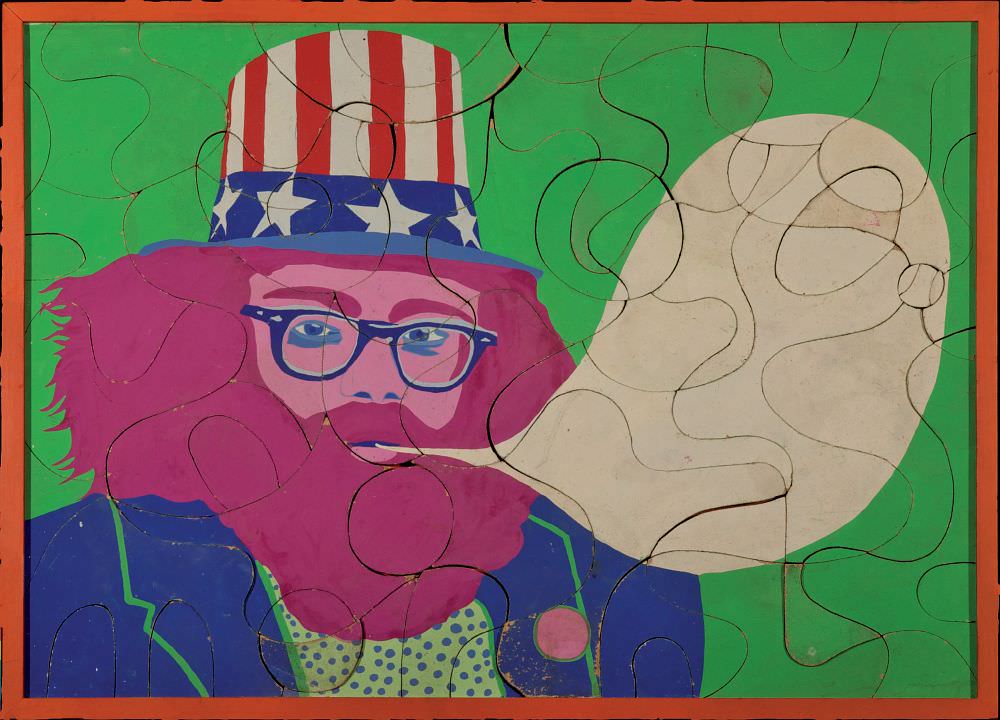
Ulrike Ottinger, Allen Ginsberg, 1966, Puzzle, Acryl auf Pressspan, 85 × 115 cm, photo by Francis von Stechow.
In the next room a single channel video plays From Its Mouth Came a River of High End Residential Appliance wherein the artist delivers a measured soliloquy on their fascination with feng shui and the inevitability of making artwork about identity. Onscreen the audience is taken through the gap of a high rise residential building on the South China Sea. This apartment-sized cut out allows the dragons who live beyond the inland hills to reach the ocean. Such design is an act of defiance to both Communism, which discourages such traditions, and Capitalism, as square footage sells at a premium in this beachside community of Hong Kong.
The last piece in the exhibition, Sliver welcomed visitors into its aura. The approximately 10 foot high statue of flexible LED Mesh and mineral dust changed color and texture in accordance with the two-channel video projected in its surface—the undulating creature has mystical draw like the oracle of delphi come to life.
“Paris Calligrammes. A landscape of memory” by Ulrike Ottinger
Haus der Kulturen der Welt
August 23—October 13, 2019
Haus der Kulturen der Welt (HKW), is known as “the pregnant oyster” because of its daring Modernist architecture. A gift from the U.S. in 1957, HKW now serves as a venue for contemporary art and cultural discourse.
In what feels like a walkable scrapbook, filmmaker and photographer, Ulrike Ottinger juxtaposes historical artifact with her own artwork to create a sociogram of Paris in the 1960s. Tapestries, books, maps, film and photos line the blue felt walls—set off by the yellow carpet.
In this “cartography of utopias” the artist take us to places that only ever existed in memory. Everything is softer in retrospective. Street art becomes tapestries, concrete becomes felt.
In one alcove two screens alternate between past and modern day footage. See historical footage of Gare du Nord, then see it in its current form. The latter takes us through the surrounding neighborhood and inside an African hair salon salon to observe the mesmerizing art of hair plaiting. In exploring the contemporary reality, the audience realized they are already romanticizing what will become the past.
“Dual Use: Miro Kaygalak”
New Company For Bildende Art (nGbK)
September 14—15, 2019
New Company For Bildende Art (nGbK), in the heart of Berlin’s Kreuzberg neighborhood, is unique contemporary art venue in that its program is discussed and voted on by its members each year. For 2019 Berlin Art Week nGbK presented “Up in Arms,” a series of billboards in the city’s metro tunnels.
At Platz der Luftbrücke and Paradestraße underground stations commuters will see new work by Miro Kaygalak. The Berlin-based artist born in Bingöl, creates dark double entendres connecting production and human rights atrocities. In Germany, laser labeled fruits are used for advertising consumer goods.In this series the artist laser labels apples with the name of one of the 5,000 victims of Iraq’s chemical warfare against the Kurdish regions in 1988—the gas smelled of apples. Also inscribed is the name of the manufacturer who produced the gas.
“Sonia Gomes: I Rise. I’m a Black Ocean, Leaping and Wide”
Museum Frieder Burda | Salon Berlin
September 7, 2019—February 22, 2020
“My work is black, it is feminine, and it is marginal. I’m a rebel.” Unequivocal words from artist, Sonia Gomes who began her career in the arts at the age of 40 and has since become one of Brazil’s most influential living artists presenting for her country at the 56th Venice Biennale in 2015.
In Gomez’s first solo show at a European institution she creates sculptures, some hanging and others free standing, from found and gifted materials such as textiles, driftwood, furniture, and wool—bound, stitched, and wrapped together. The pieces are soft and feminine, but the organic shapes allude to the brutalized bodies of lynching victims. One is unsure if these are talismans of luc, or objects of warning.
“1989-2019: Politics Of Space In New Berlin”
New Berliner Kunstverein (N.B.K.)
September 12—October 13, 2019
At “1989-2019: Politics Of Space In New Berlin,” the audience is reminded that art isn’t just emotive, it’s instructive. Show and tell go hand in hand in this group exhibition exploring delves into policies behind the privatization of Berlin’s municipal space and how the creative subcultures have been weaponized to drive up property values.
Two notable works explore how esoteric or euphemistic jargon camouflages shady real estate dealings. In the “Glossary of Privatization,” artist Andrej Holm draws attention to the administrative language used to rationalize the sale of state-owned property. Patrons could rip off pages of paper from around 20 tear-stacks, each printed with a real estate term and its definition, taking ownership of the terminology meant to keep the public at bay. While Guerilla Architects create a film glossary in the “Language of Speculation” in what seems like a caricature of a corporate video.
Positions Berlin Art Fair
September 12—15, 2019
Housed in a sometime airport hanger of Tempelhofer Feld, Positions Berlin Art Fair looked out over what is now 750 acres of lush public park. Patrons entered under an installation from Cicada Concepts, “It’s hard to name something we’ve never seen before.” a ceiling of foil streamers hanging from a metal scaffold archway about 15-feet high. The strips rustled high in the air producing a calm swishy sound like holding one’s ear to a seashell.
Inside Hangar 4, 70 galleries from 12 countries exhibited for the sixth edition of the fair which focuses on contemporary and modern art. A luminescent work from the student section drew visitors to a dim room on the side of the main hall. From artist Julia Walk’s “Shave 2019” series, two bright yellow metal boxes, forged by her brother, frame inset photographs each of a leg against a cobalt background. The viewer’s perspective of the legs are as of one’s own legs in a bath. The leg hair is shaved into fun designs and the toes are painted the same color as the background. Warm with humor, the piece invites us to question what we are allowed to celebrate.






